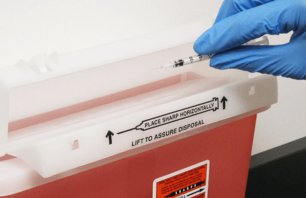Dental clinics take critical steps to maintain safe and healthy practices as they work hard every day to deliver quality preventative care and treatment to their patients.
It can take a great deal of effort for dental teams to manage multiple regulated waste streams while staying up to date with regulatory requirements. The following best practices aim to help dentists, dental hygienists, dental assistants, and dental office staff promote safety for their patients and their entire team.
Put Safety First
Patient and workplace safety is essential to quality oral health care. Dentists and their staff must be vigilant when following waste removal strategies to avoid exchanging cold and flu viruses, bacteria, environmental toxins, or bloodborne pathogens.
- Proper disposal of dental sharps. Dental practices should have policies and procedures in place to address sharps safety, including precautions for using sharps, such as dental needles, during clean up and disposal. Safe handling procedures, along with specially designed waste receptacles, can limit needlestick injuries that may expose dental healthcare personnel to bloodborne pathogens. Sharps containers should be puncture-resistant, leak-proof, designed to prevent overfilling, and located where sharps are generated.
- Proper disposal of regulated medical waste. Dental staff should also ensure correct disposal of other regulated medical waste, such as gauzes or procedural drapes saturated with blood. Color-coded or labeled biohazardous waste bags should be used to dispose of these potentially infectious materials properly.
- Proper disposal of hazardous wastes. Some chemicals used in dental practices may be regulated as hazardous waste. The Environmental Protection Agency (EPA) and state equivalents require all generators to perform assessments to determine if the waste they generate is a hazardous waste; this is known as performing a waste characterization. Common items in dental practices that may be hazardous waste include certain pharmaceuticals, fixer, developer, disinfectants, batteries, fluorescent lamps, and amalgam. It is also important to point out that none of these chemical wastes can be disposed in the red bag or sharps containers as regulated medical waste, even if determined to be non-hazardous. Stericycle can connect you with a vendor to assist with the management of these waste streams.
The EPA also has regulations applicable to dental facilities that place or remove dental amalgam and that discharge wastewater to municipal sewer systems. It is required that such facilities remove dental amalgam using amalgam separators – equipment that can remove particles of amalgam from wastewater – and that these separators are properly installed, maintained, monitored, and disposed.
Actively Participate in Compliance Training
A lack of compliance with safety regulations and the recommendations above may compromise a patient’s or a team member's well-being. Adhering to the following regulatory training requirements can go a long way toward consistent compliance.
- Biohazardous waste: All states recommend training upon the initial assignment, and some state waste authorities require annual training.
- Hazardous Materials: The Department of Transportation requires training upon initial assignment and every three years thereafter for those who sign shipping papers or package hazardous materials for transport.
- Workplace Safety: The Occupational Safety and Health Administration (OSHA) requires that dental practices provide thorough orientation and refresher training on several topics, including:
- OSHA Bloodborne Pathogens: Required by OSHA upon initial assignment and annually thereafter.
- OSHA Hazard Communication Awareness: Required by OSHA upon initial assignment and with the introduction of any new hazardous chemicals thereafter.
- Privacy and Security: The Health Insurance Portability and Accountability Act (HIPAA) requires that privacy and security training be completed upon initial assignment and recommend annual training thereafter.
Fortunately, there are online training modules, such as those offered by Stericycle, which enable organizations to meet OSHA. These easy-to-use tools are available 24/7/365, so staff can complete them at their convenience. The modules also document that training has been completed for situations where the practice must document that training has occurred.
Solutions for a Safe, Compliant Workplace
In addition to online compliance training, Stericycle offers medical waste disposal and management solutions to help dental practices ensure a safe, compliant workplace, including:
- Safe Needle Disposal: Whether disposable or reusable, Stericycle containers are designed with safety in mind to help compliantly dispose of sharps and reduce needlestick injuries.
- Sharps Disposal Container and Service Options: Reusable, mail back, and disposable sharps containers, as well as full service and self-service options for sharps container exchange are available.
- Biohazardous Medical Waste Solutions: Compliant collection, transportation, treatment, and disposal of regulated waste are available solutions.
- Amalgam Mailback Program: Safely dispose of amalgam and keep mercury out of our waterways.
- Pharmaceutical Waste Solutions: Safe and compliant disposal of hazardous and non-hazardous medication waste, including expired, partially used, or contaminated medication or ointments and anesthesia gas waste are available.
- Hazardous Waste Solutions: Full hazardous waste management, including wastes that require proper attention, such as flammable liquids, xylene, formalin, aerosols and universal waste.
Learn more about how Stericycle can help your dental office put safety and compliance first.



